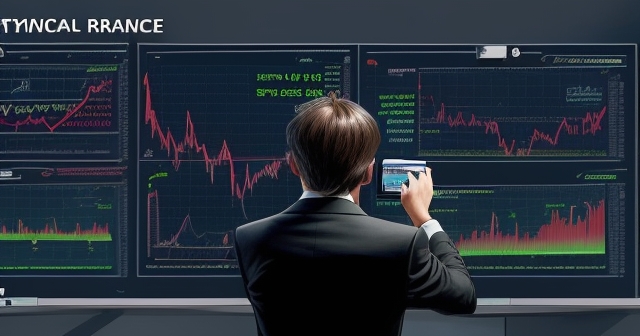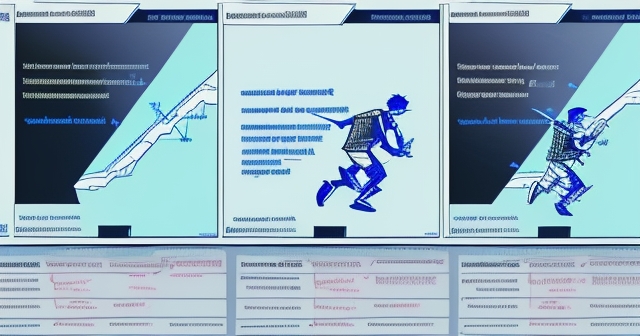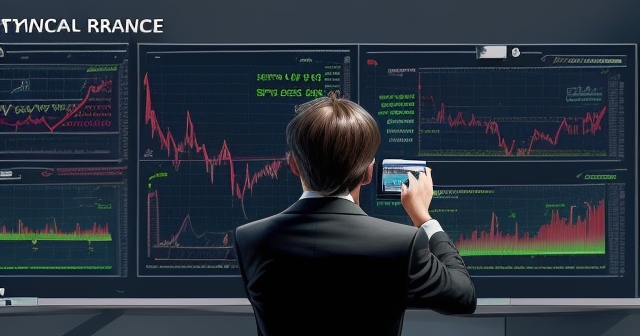Decoding “Fading” in Financial Trading: A Contrarian’s High-Risk Path
Welcome, aspiring traders and seasoned market navigators. Today, we embark on a deep dive into a concept that often stirs debate and demands a certain courage: fading in trading. This isn’t about slowly disappearing from the market; rather, it’s a bold act of stepping into the path of a moving trend, anticipating its exhaustion or reversal. The term “fading” actually carries a dual meaning within the financial world, and understanding both is crucial for anyone looking to master the complexities of trading. We will explore fading as a distinct, often high-risk, contrarian trading strategy, and we will also shed light on its separate, regulatory-linked definition concerning market makers.
As we unpack this concept, we’ll adopt the perspective of a mentor guiding you through potentially turbulent waters. We aim to illuminate the “why” and the “how” behind this fascinating approach, demonstrating how it fundamentally differs from the more widely adopted practice of trend following. Prepare to challenge your conventional thinking about market movements, as fading requires a mindset that goes against the prevailing sentiment, seeking opportunity where others see only momentum. This is not a strategy for the faint of heart or the unprepared, but for those who understand its nuances and risks, it can offer unique possibilities.

At its heart, fading as a trading strategy is the quintessential contrarian strategy. Instead of riding a wave of momentum, a fade trader aims to profit from the wave’s eventual collapse or recoil. This means taking a position opposite to the dominant market direction. When prices are surging upwards rapidly, the fade trader contemplates selling (going short). Conversely, when prices are plummeting sharply, they consider buying (going long). Why would anyone intentionally step in front of what appears to be an unstoppable force?
- Faders anticipate market corrections.
- They believe in market psychology and its effects on price movements.
- Successful faders require exceptional risk management skills.
The premise underlying the fading strategy rests on the belief that market movements, particularly rapid or extensive ones, often involve an element of market overreaction or become stretched beyond sustainable levels in the short term. Early participants might have driven the initial significant move, but later stages of the trend can often be fueled by panic, euphoria, or late-arriving, less-informed traders (sometimes referred to as the “dumb money”). A fade trader seeks to exploit this perceived overextension, betting that the enthusiasm or despair is reaching its peak and a trend reversal or at least a significant correction is imminent. This requires a deep understanding of market psychology and the lifecycle of price movements.
Consider a stock price that has skyrocketed 20% in a single day on seemingly minor news. While the trend follower might be tempted to buy, expecting further gains, the fade trader sees potential vulnerability. They might view this extreme move as unsustainable hype, driven by FOMO (Fear Of Missing Out), and might look for an opportunity to short the stock, anticipating a pullback. Similarly, a currency pair experiencing a sudden, sharp decline could be seen by a fade trader as an opportunity to buy, believing the selling pressure is overdone and due for a bounce.

Successfully implementing a fading strategy is far more complex than simply observing a strong move and betting against it. It requires sophisticated analysis to identify points where the market is genuinely vulnerable to a reversal, rather than simply experiencing a temporary pause before the dominant trend resumes. This is where technical analysis, understanding market structure, and potentially fundamental context become critical tools for the fade trader.
One key aspect of identifying fade opportunities is recognizing signs of overextension or exhaustion in a market move. These signs aren’t always immediately obvious and often require looking beyond just the price itself. Are the buyers or sellers who drove the initial move starting to show weakness? Is the price moving up on declining volume, suggesting a lack of conviction? Has the price reached a significant historical resistance level during an uptrend, or support level during a downtrend, that previously triggered reversals?
| Sign of Overextension | Explanation |
|---|---|
| High Volume on Price Uptrend | Indicates strong buying interest. |
| Price Approaching Resistance | Potential area for reversal. |
| Divergence Between Price and Indicators | Price increases while indicator shows weakness. |
Furthermore, understanding the potential impact of news or scheduled events is vital. While news often initiates strong trends, the immediate reaction can sometimes be an overreaction that quickly corrects. A fade trader might specifically target the volatility spike immediately following a major economic data release, betting that the initial impulsive move will partially or fully retrace as the market digests the information more rationally. This is particularly common in the Forex market, where rapid reactions to data like the Non-Farm Payrolls Report can present fleeting fade opportunities.
Identifying these moments requires discipline and patience. You aren’t chasing the initial move; you are waiting for the market to signal its potential weakness *after* that move has occurred. This often involves observing price action around key levels, monitoring the momentum’s rate of change, and looking for specific technical confirmations that suggest the dominant force might be losing control.

Technical analysis provides fade traders with a powerful toolkit to scout for potential entry and exit points. While trend followers might focus on indicators designed to confirm momentum, fade traders lean heavily on tools that help identify potential exhaustion, overbought or oversold conditions, and signs of impending reversal.
Oscillators are perhaps the most common technical indicators used in fading. These indicators, such as the Relative Strength Index (RSI) and the Stochastic Oscillator, measure the speed and change of price movements. They are designed to fluctuate within a range (typically 0 to 100) and signal when an asset might be trading at extreme levels relative to its recent price history. When an oscillator reaches “overbought” territory (e.g., above 70 on RSI, above 80 on Stochastic), it suggests that the price has risen too quickly and may be due for a pullback. Conversely, “oversold” levels (e.g., below 30 on RSI, below 20 on Stochastic) suggest a rapid decline that might be ripe for a bounce.
| Indicator | Description |
|---|---|
| Relative Strength Index (RSI) | Measures momentum and indicates overbought/oversold levels. |
| Stochastic Oscillator | Compares a particular closing price to a range of prices over time. |
While oscillators can provide valuable signals, they are best used in conjunction with other forms of analysis, as they can remain in overbought or oversold territory for extended periods during strong, sustained trends. A fade trader looks for divergence between the oscillator and the price (e.g., price makes a new high, but the oscillator makes a lower high), which can signal weakening momentum even as the price continues to move in the direction of the trend.
Beyond oscillators, chart patterns that signal potential reversals are also critical. Patterns like double tops or bottoms, triple tops or bottoms, and the Head and Shoulders pattern are classic technical formations that suggest a market trend may be culminating and preparing for a significant change in direction. Observing price action as it interacts with previous swing highs or lows, or fails to make convincing new highs/lows, provides visual cues that align with the fade trader’s premise of trend exhaustion.

One specific environment where fading sees frequent application, particularly among experienced Forex traders, is around significant economic news releases. These events, such as interest rate announcements, GDP figures, or employment reports, can trigger massive, rapid price swings as algorithmic trading systems and human traders react instantly to the new information. The initial reaction, however, is often characterized by high volatility and can sometimes overshoot the mark.
A fade trader might position themselves to trade against this initial impulsive move. For example, if the Non-Farm Payrolls report in the US comes out significantly better than expected, the USD might spike sharply higher against other currencies like the JPY (USD/JPY). A fade trader might see this rapid spike as potentially overdone in the very short term and look to short USD/JPY, anticipating a quick retracement of some of the gain as the market settles down and reassesses the long-term implications of the data.
This approach is inherently risky because the news might indeed signal the start of a new, powerful trend. Therefore, event-driven fading requires split-second execution, precise timing, and very tight risk management, typically using stop-loss orders placed just beyond the perceived point of maximum overreaction. The aim is usually to capture a quick, sharp profit from the immediate snap-back, not to ride a long-term reversal.
| Event-Driven Fading Opportunity | Example |
|---|---|
| Economic Releases | Post Non-Farm Payrolls report trading. |
| Market Gaps | Trading against significant opening price gaps. |
Another event-driven fading opportunity arises with market gaps. A gap occurs when the opening price of a trading period (like a day or week) is significantly higher or lower than the closing price of the previous period, often due to overnight news or sentiment shifts. A common fading strategy is to bet that the market will “fill the gap” – meaning the price will move back to cover the range of the gap, effectively trading against the direction of the gap itself. If a stock opens significantly higher, a fade trader might short it, expecting it to fall back and “fill” the upward gap. This assumes the gap was based on transient emotion or less significant news and the market will quickly revert to its previous trading range.
Trading economic news or gaps requires a sophisticated understanding of market mechanics and the typical post-event price action. It’s a different beast than fading based purely on technical patterns in established trends and is often best suited for the high-speed environment of the Forex or futures markets.
If you’re considering venturing into Forex trading or exploring various CFD instruments, Moneta Markets is a platform worth considering. Hailing from Australia, it offers over 1000 financial instruments, catering to both novice and professional traders alike.
We’ve touched upon it repeatedly, but it bears emphasizing with full force: fading is a high-risk strategy. This is not a gentle paddle in calm waters; it is actively swimming against a current. The primary and most significant risk is that the trend you are attempting to fade simply continues, gathering more strength and moving aggressively against your position. What you perceived as market overreaction might, in fact, be the initial thrust of a prolonged and powerful directional move driven by fundamental shifts or strong institutional flows.
Imagine shorting a stock because you think it has risen too fast, only for major positive news to be released moments later, sending the price parabolic. Or buying a currency pair you believe is oversold, just as a central bank announces aggressive quantitative easing, triggering a sustained collapse in value. In such scenarios, a fading position can incur substantial, rapid losses.

Beyond the risk of trend continuation, fade traders also face the challenge of whipsaws. These occur when the price temporarily moves against the main trend, luring fade traders in, before quickly snapping back to continue the original direction. This can lead to multiple losing trades as the market tricks participants into believing a reversal is underway when it’s merely a brief correction.
The psychological toll of fading is also considerable. Going against the crowd, especially when that crowd appears to be consistently right as the trend extends, requires immense discipline and emotional control. It can be psychologically taxing to watch your position move against you while the dominant narrative screams that you are wrong. This pressure can lead to premature exits (cutting winners short) or, worse, stubborn adherence to a losing position (“averaging down” into a falling market or “averaging up” into a rising market) in the hope of a turnaround, which can be catastrophic.
Because of these inherent dangers, fading is unequivocally **not recommended for novice traders**. It demands a level of experience, market intuition, sophisticated analytical skills, and ironclad discipline that typically takes years to develop. Beginners should focus on less complex strategies, such as basic trend following, where the mechanics are simpler and the risks, while still present, are arguably easier to manage initially.
Given the elevated risks associated with fading, truly mastering this approach is less about predicting the perfect turning point and more about implementing flawless risk management. For a fade trader, risk management isn’t just a suggestion; it’s the bedrock of survival. Without stringent controls, a single wrong call against a strong trend can wipe out weeks or months of accumulated profits, or worse, significantly deplete trading capital.
| Risk Management Technique | Description |
|---|---|
| Stop-Loss Orders | Predefined exit point to limit losses. |
| Position Sizing | Determines the size of trades based on capital. |
| Emotional Control | Avoid impulsive decisions based on fear or greed. |
The cornerstone of risk management for fade traders is the intelligent use of stop-loss orders. A stop-loss order is an instruction to your broker to close your position automatically if the price moves against you to a predetermined level. For a fade trader, setting a tight stop-loss is absolutely critical. Because you are betting on a short-term snap-back or reversal, if the market continues to trend strongly against your position and hits your stop, it is a clear signal that your initial premise was incorrect (at least for the moment), and holding on would likely lead to larger losses. The stop-loss limits the maximum potential loss on any single trade.
Position sizing is equally vital. Fade traders must carefully determine the size of their trade based on their overall trading capital and the distance to their stop-loss. A common guideline is to risk only a small percentage (e.g., 1% to 2%) of your total trading capital on any single trade. This means that even if your stop-loss is hit, the resulting loss is a manageable dent, not a catastrophic blow. Trading too large a position relative to your capital, especially with a strategy as risky as fading, is a recipe for disaster.
Furthermore, successful fade traders understand that not every perceived opportunity will lead to a successful fade. They accept that they will have losing trades. What differentiates profitable fade traders is their ability to keep those losses small and manageable while allowing winning trades, when they occur, to generate sufficient profit to offset the losses and yield an overall gain. This requires discipline, patience, and the emotional resilience to adhere to your trading plan even after a series of small losses.
In essence, risk management transforms fading from a reckless gamble into a calculated strategy. It’s about defining your maximum acceptable loss before entering the trade and strictly adhering to that limit, no matter how convinced you are that the market *must* turn around. It’s about protecting your capital first, knowing that there will always be another trading opportunity tomorrow.
While complex event-driven fading is common in high-speed markets, simpler forms of contrarian strategies that embody the spirit of fading can be found elsewhere. One well-known example, though less about short-term price action and more about long-term stock selection, is the “Dogs of the Dow” strategy. This approach involves investing annually in the ten stocks within the Dow Jones Industrial Average (DJIA) that have the highest dividend yield. The underlying premise is that stocks with high dividend yields are often those that have recently underperformed (their price has fallen relative to their dividend payout), making them temporarily “out of favor” or “oversold” within the index. The strategy essentially “buys the dip” on these large-cap stocks, betting that their underperformance is temporary and they will revert towards the mean.
Another example, closer to the day-to-day fading we’ve discussed, might occur when a company releases an earnings report that causes its stock price to gap down significantly at the open. A fade trader might analyze the situation and conclude that the market’s reaction is excessive relative to the actual financial impact of the report. They might then buy the stock, placing a stop-loss just below the gap’s low, betting on a partial or full “fill” of the gap as cooler heads prevail or short-sellers cover their positions.
In the Forex market, consider the volatility surrounding the Russian invasion of Ukraine in early 2022. The Russian ruble (USD/RUB) plummeted dramatically. While many would fear touching such a volatile pair, some highly experienced traders might have viewed the initial, panic-driven collapse as an overreaction, anticipating that sanctions and geopolitical dynamics, while severe, might not justify *that* extreme a move in the short term. A fade trader might have looked for technical signs of slowing momentum in the ruble’s fall and attempted to buy, aiming for a bounce. This is an extreme example, highlighting the incredible risk, but it illustrates the core idea of betting against a dominant, fear-fueled move.
Thus far, we’ve focused on fading as a trading strategy used by investors to profit from anticipated reversals. However, the term “fade” has a distinct and important meaning in the context of market makers and exchange rules. This second meaning is not about taking a contrarian trading position, but about a failure to fulfill a specific obligation.
In many financial markets, particularly those for options, equities, and some fixed income products, market makers (sometimes called dealers) play a crucial role in providing liquidity. They stand ready to buy and sell a particular asset and publicly display bid (buy) and offer (sell) prices at which they are willing to trade a certain quantity. This makes it easier for other market participants to execute their trades.

In this context, a market maker is said to “fade” a quote if they fail to honor their published bid or offer price when another market participant attempts to trade at that price. For example, if a market maker displays a bid to buy a stock at $50.00 for 100 shares, and a trader attempts to sell 100 shares to them at that price, the market maker is obligated to fill that order. If the market maker refuses to buy at $50.00 or changes their quote away just as the order arrives, they are “fading” the quote.
This action disrupts the market’s functioning and can be detrimental to traders who rely on the displayed quotes for execution. It became a significant concern, especially in equity options markets, as technology allowed for faster trading and made it easier for market makers to pull quotes quickly.
The practice of market makers fading quotes led to the implementation of specific regulations designed to ensure fairness and orderliness in the market. One prominent example was the “Trade-or-Fade Rule” in the US equity options market. This rule, enforced by the Securities and Exchange Commission (SEC), aimed to prevent situations where market makers displayed favorable quotes but then withdrew them or refused to trade when an order arrived.
The original Trade-or-Fade Rule essentially mandated that if a market maker displayed a quote for a certain size (e.g., a bid for 10 contracts of an options series), they were obligated to either “trade” at that price up to that size when presented with an order or “fade” their quote by immediately displaying a new, revised quote. The “fade” option under the rule still allowed changing the quote, but it required posting a new, valid quote, preventing outright refusal without updating. The spirit was to ensure market makers actively participated based on their displayed prices.
However, the evolution of electronic trading and the rise of high-frequency trading created new challenges. The rule sometimes struggled to keep up with the speed at which quotes could be changed or “refreshed.” This led to issues like “phantom quotes,” where a favorable price would appear for a split second only to vanish before a trader could execute, effectively a modern form of fading.
Recognizing these limitations, the SEC revised and replaced the Trade-or-Fade Rule in 2001 with the “Firm Quote Rule” (also known as Rule 602 of Regulation NMS – National Market System). The Firm Quote Rule strengthens the obligation of market makers to honor their displayed quotes. It requires that published bids and offers from market centers (including market makers) must be “firm” – meaning they must be tradable at the stated price for at least the displayed size, unless an exception applies (like a communication or systems issue). This rule significantly reduced the instances of market makers unfairly fading quotes, enhancing transparency and execution certainty for market participants and contributing to a more efficient market structure, particularly in preventing “trade-throughs” where an order is executed at an inferior price on one market center when a better price is available and accessible on another.
To truly grasp the nature of fading, it is helpful to contrast it with its diametric opposite: trend following. These are two fundamentally different philosophies of engaging with the market’s direction, appealing to different trader personalities and risk appetites.
Trend following assumes that once a market establishes a direction, it is more likely to continue in that direction than to reverse. Trend followers aim to identify established trends and ride them for as long as possible. They buy rising assets and sell falling assets, using indicators like moving averages, directional movement index (ADX), or simple price action to confirm the presence and strength of a trend. Their risk comes from entering late in a trend or getting caught in unexpected reversals, but their core premise aligns with the market’s observable momentum.
Fading, on the other hand, assumes that trends, particularly rapid or extended ones, eventually exhaust themselves and are prone to periods of correction or outright reversal. Fade traders bet against the immediate direction, buying dips in downtrends and selling rallies in uptrends. Their risk is the trend’s continuation, which can lead to swift and significant losses. Their success hinges on accurately identifying points of extreme sentiment or temporary inefficiency that will lead to a counter-trend move.
Here’s a quick comparison:
- Premise: Trend Following believes “the trend is your friend”; Fading believes “the trend eventually bends.”
- Action: Trend Followers buy strength and sell weakness; Fade Traders sell strength and buy weakness (relative to the immediate trend).
- Risk: Trend Followers risk whipsaws and late entry into dying trends; Fade Traders risk the trend continuing strongly against them.
- Market Type Preference: Trend Following thrives in clear, sustained trending markets; Fading can be more effective in volatile or range-bound markets where movements are less sustained, or around specific high-impact events.
- Patience: Trend Followers need patience to hold positions for potentially long periods; Fade Traders often seek quicker profits from sharp counter-moves and require patience waiting for extreme conditions.
By now, it should be clear that fading is not a casual undertaking. It demands a specific blend of skills, knowledge, and psychological attributes. If you are considering incorporating fading into your trading repertoire, or even just exploring its potential, it’s crucial to honestly assess whether you possess the necessary prerequisites.
Firstly, extensive market experience is paramount. This isn’t a strategy you learn in a weekend. Successful fade traders typically have spent years observing market behavior, understanding the nuances of price action, and gaining a deep intuitive sense of when a move feels overextended. They have likely traded through various market cycles and understand how sentiment and momentum typically ebb and flow.
Secondly, a strong foundation in technical analysis is non-negotiable. As we discussed, oscillators, chart patterns, support/resistance analysis, and potentially Fibonacci levels are key tools. A fade trader needs to be adept at reading charts and identifying potential reversal signals *before* they become obvious to the majority.
Thirdly, impeccable risk management skills and disciplined execution are critical. This goes beyond just setting a stop-loss; it involves strict position sizing, knowing when to walk away after a series of losses, and never deviating from your predefined risk parameters out of hope or frustration. Capital preservation is the absolute priority.
Fourthly, a robust psychological makeup is essential. Fading means going against consensus, which requires confidence in your analysis and the ability to withstand periods where the market tells you you’re wrong (at least temporarily). You must be able to manage fear and greed effectively, avoid impulsive decisions driven by emotion, and stick to your trading plan even under pressure.
Finally, patience is vital, but it’s a different kind of patience than in trend following. While trend followers wait for a trend to develop and then patiently ride it, fade traders patiently wait for the *extreme* conditions that signal a potential fade opportunity. They don’t trade constantly; they lie in wait for specific, high-probability setups that align with their contrarian view.
If these prerequisites sound daunting, that’s because they are. Fading is a strategy best suited for those who have already built a solid foundation in trading fundamentals and are looking to explore more advanced, higher-risk techniques. Attempting to fade without these skills is likely to lead to frustrating and costly outcomes.
We’ve journeyed through the multifaceted concept of fading, distinguishing between its application as a daring contrarian trading strategy and its technical meaning concerning market makers‘ obligations. As a trading approach, fading involves strategically betting against the prevailing market trend, seeking to profit from overreactions and anticipated reversals, often triggered by technical signals or specific market events like news releases or gaps.
In conclusion, while fading as a trading strategy offers the potential for significant short-term gains, it is unequivocally a high-risk strategy that requires a deep understanding of market dynamics, advanced analytical skills, impeccable discipline, and extensive experience. It is a powerful tool, but one best wielded by experienced traders who have mastered the art of managing risk. For novice traders, focusing on less complex strategies that align with market momentum is a more prudent path to building a sustainable trading career. Approach fading with respect for its difficulty and the necessary preparation, and you might find opportunities where others only see danger.
If you are seeking a regulated broker that caters to diverse trading styles and offers robust platforms, potentially for applying strategies discussed (with appropriate experience), then evaluating what Moneta Markets provides could be a beneficial step in your trading journey. Their commitment to supporting various trading platforms and providing essential resources like 24/7 customer support demonstrates a focus on empowering traders.
what does fading mean in tradingFAQ
Q:What is fading in trading?
A:Fading is a contrarian trading strategy where traders bet against prevailing market trends, anticipating corrections or reversals.
Q:What are the risks of fading?
A:The primary risks include trend continuation leading to losses, market whipsaws, and psychological challenges when going against the consensus.
Q:Is fading suitable for beginners?
A:No, fading is not recommended for novice traders as it requires extensive market experience, risk management skills, and psychological resilience.
